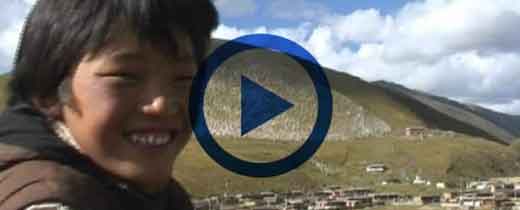Batang County is a county in southwest of Garze Tibetan Autonomous Prefecture.
“Batang” is transliterated from Tibetan with meaning of auspicious. Among them, “Ba” is Tibetan pronunciation of sheep calls; “Tang” means “Ba-zi” (meaning “Open grassland”) in Tibetan, To have this two words together means “on a large meadow, the sound of sheep calls can be heard everywhere.”
Location
Batang County is a grassland surrounded by high mountains, where cattle and sheep are grazed, and the sound of sheep calls can be heard everywhere. so this place was named “Batang”
Xiaqiong Town, the county seat of Batang County, is 2580 meters above sea level, about 450 kilometers away from Kangding and 760 kilometers away from Chengdu. It borders Xiangcheng County and Litang County in east, Derong County in south, Markam County, Gonjo County and Deqen County across Jinsha River in west, and Pelyul County in north.
Batang County is the last town in Sichuan before entering Tibet on southern Sichuan-Tibet road, and it is also the choke point from Sichuan to Tibet.
Best time to travel
From May to October
Local climate
Alpine and plateau climate
Most popular sites
“Zu-Ba-Long Nature Reserve” is located at between “Zu-Ba-Long village” and “Su-Wa-Long village”, it is 19 kilometers from south to north, and 12 kilometers from east to west, covering a area of 14240 hectares, the highest spot of this reserve is 5,096 meters, the lowest spot is at 2,680 meters. This is only Nature reserve for protecting “Dwarf Rock Sheep” in southwest of China, which is also the breeding ground of Dwarf Rock Sheep in Sichuan Province
Batang Chode is located at the intersection of Bajiu River and Bachu River. During the reign of Batang by Mu clan chieftain of Lijiang, this place was once the official village of Mu clan chieftain. Today’s Batang Chode occupies only about one-fifth of previous area , but it still looks magnificent and majestic.
In 1637 AD, Bon believers in Batang built a Bon religion monastery, named “Dango Monastery“. Later, it was moved to Zhajinding in northeast of Batang county, and was renamed as “Zata Monastery” and converted to be a Kagyu pa monastery. When Gelug pa of Tibetan Buddhism was introduced to Batang in 15th century, and this monastery then converted to be a Gelug pa monastery. In 1652 AD, the 5th Dalai Lama dispatched his subordinates to Batang, modeled on Drepung Monastery’s Loselin College, and expanded it on scale of the original site of “Zata Monastery”, and personally named the monastery as “Ganden Pendeling”. Because of the support of Qing dynasty’s government, This monastery was also given a Chinese name “Kangning Temple (also known as Dingning Temple)”.
Rideng Monastery, also known as “Jakhyung Rito Pendeling” or “Ba Rito Gompa“, was built in 1820 AD and belongs to Gelug sect. The temple is located in Rideng Village about 2 kilometers away from Xiaqiong Town. It contains numerous original Thangkars and a chapel dedicated to 4th Panchen Lama. Nowadays, it houses 3 monks and it is the site of Batang County Buddhist Association.
Geography and climate
Batang County is located at junction of three provinces (region) of Sichuan, Yunnan and Tibet on the east bank of middle reaches of Jinsha River. About 260 kilometers from north to south, 45 kilometers from east to west, covering an area of 8,186 square kilometers, the county has an average elevation of 3,300 meters. Shaluli Mountains rise above the east of Batang County, and Hengduan Mountains run through entire county.
The terrain of Batang County slopes from north to south along the direction of Jinsha River, and is high in north & east, and low in south & west.
–In North, Dangji Zengran Peak is 6060 meters above sea level, which is the highest point in this county, and most of other peaks are about 5000 meters.
–In South-Central, alpine valley area is generally below 2800 meters above sea level, and the lowest point is Meironglong Village of Gongbo Township with an elevation of 2240 meters
–In Central and Eastern, the elevations of semi-alpine and high mountainous areas are generally between 2,800 and 3,300 meters.
Haizi Mountain in Batang County is located between Litang and Daocheng counties, with an average elevation of 4,500 meters. The highest peak, Guoyinritse, is 5,020 meters above sea level. There are about more than 1,100 large and small Haizi (meaning “lake”). Due to its scale density of Haizi (lake), hence, the mountain is named Haizi Mountain with meaning mountain with many lakes
All rivers in Batang County belong to Jinsha River system. Jinsha River runs through western of Batang county from north to south with total length of 167 kilometers, and an average flow of 943 cubic meters per second, a total annual runoff of 29.719 billion cubic meters.
The main river in Batang county is Bachu, which originated from Zakinjabo Glacier. Dingchu originated on west of Harilah in Bomi Township, with a length of 116 kilometers in Batang County.
The latitude of Batang County is at 30 degrees north latitude. Its temperature rises rapidly in spring, and the highest temperature in summer can reach over 35℃. The rainy season is mainly concentrated from June to September. In autumn, the microclimate is frequent due to the alternating hot and cold air currents. In winter, it gets colder, the lowest temperature can reach below -10℃, and there is less rain and snow.
Annual average temperature is 13℃, annual average sunshine hours is 2451 hours, temperature difference between day and night is large, annual rainfall is 476 mm, and average frost-free period is 119 days.
Population and ethnicity
As of 2019, the total population of Batang County has reached 53,000, of which Tibetans account for 96.61% of total population. Other ethnic groups include Han, Yi, Hui, Qiang, Naxi, Mongolian, and Miao people
How to get to Batang
The airports that near Batang county are three, one is Qamdo Bangda Airport (BPX, 4,334m), which 420 kilometers approximately northwest from Batang. It takes more than 8 hours to cover this distance, however, due to the permit and travel restriction on foreign visitors, this airport is not recommended;
Another one is Daocheng Yading Airport, it is 280 kilometers southeast from Batang via Litang, it takes about 5 hours to cover this distance;
The 3rd one is Kangding Airport (KGT, 4,238m) which is 385 kilometers eastward, it takes 6-7 hours drive to cover this distance.
Batang has regular buses to Litang, Kangding, and Chengdu, and short distance bus to Markhang of Tibet,
Be advised: without Tibet Travel Permit, Foreigners are not allowed to enter Tibet from Batang
By vehicle between Batang and Litang
There is one daily bus to Litang from Batang;
In addition to this daily bus, there are rented vehicle available in this town, it usually cost RMB 600.00 – 900.00 one way for a private ride between Litang and Batang
By flight
Taking flight to Daocheng Yading Airport (DCY) or Kangding airport(KGT), then switch to local bus to get to Batang;
- by bus departure from Daocheng Yading Airport: it takes 5 hours to reach Batang
- by bus departure from Kangding: it takes 7-8 hours to reach Batang
Kangding Airport
Contact: +86 836 282-7811
IATA Code: KGT
Altitude: 4,238 meters
Daocheng Yading Airport
Contact: +86 836 572-4015
IATA Code: DCY
Altitude: 4,411 meters
Qamdo Bangda Airport
Contact: +86 895 482-1004
IATA Code: BPX
Altitude: 4,334 meters
Batang Bus Station
Add : Jinxianzi Avennue By N318 Road
Contact : +86 836 562-2300
Altitude : 2,240 meters
Distance from Batang to
- Litang : 170 kilometers, about 3 hours drive
- Yading Nature Reserve: 400 kilometers, about 7 hours drive
- Zogang : 260 kilometers, about 5.5 hours drive
- Kangding : 450 kilometers, about 9 hours drive
- Shangri La : 366 kilometers, about 10 hours drive
Brief History
In ancient times, Batang area was land of different tribes
In Zhou Dynasty (1100 BC-256 BC), it was called “Rong”,
In Qin Dynasty (221 BC-207 BC), it was called “Xi(West) Qiang”
In Han Dynasty (202 BC-220 AD), The “White Wolf Kingdom” was established in the land of Batang
During Three Kingdoms (220 AD-280 AD), Wei, Jin, Southern and Northern Dynasties (220 AD-589 AD)), White Wolf Kingdom continued to exist independently
In 618 AD, White Wolf Kingdom was annexed to Tang Dynasty
In 667 AD, White Wolf Kingdom was destroyed by 32nd Tibet king Songtsen Gampo, and Batang area was ruled by Tubo kingdom from then on
In Yuan Dynasty, it was under jurisdiction of Do-kham High Pacification Commissioner’s Office
In Ming Dynasty, it was under jurisdiction of Do-kham Itinerant Commandery
From 1568 AD to 1639 AD, the chieftain of Mu clan of Naxi tribe of Lijiang captured and took control of Batang area
In 1639 AD, Batang was ruled by Qinghai Khoshot Khanate Gushi Khan
From 1646 AD to 1701 AD when Batang was recovered by Qing dynasty, Ganden Phodang regime of Tibet ruled Batang for 55 years
In 1726 AD, Batang was placed under Sichuan province
In the 33rd year of Emperor Guangxu of Qing Dynasty (1907), Ba’an County was established after the “Gaitu Guiliu (Administrative Regularization)”.
Gaitu Guiliu, also known as “conversion of chieftain system” or “conversion of abandoning chieftain system”, refers to abolition of chieftain who originally ruled ethnic minorities. Instead, officials appointed by the central government. It began in Emperor Yongle’s period at the beginning of Ming Dynasty and was implemented on a large scale during Emperor Yongzheng’s period of Qing Dynasty.
In the 34th year of Emperor Guangxu of Qing Dynasty (1908), Ba’an County was changed to Ba’an Fu, which was the beginning of Batang County
In 2nd year of Republic of China (1913), it was restored to Ba’an County
In 3rd year of Republic of China (1914), Ba’an County was part of Sichuan Border Special Administrative Region.
In 14th year of Republic of China (1925), it belonged to Xikang Special Administrative Region.
In 28th year of Republic of China (1939), it belonged to 5th administrative inspectorate of Xikang Province.
In 1950, Provisional Government of Ba’an County was established.
In 1951, Ba’an County was abolished, and Batang County was officially established
In 1955, Xikang Province was abolished, and Garze Tibetan Autonomous Prefecture was established, since then Batang County was placed under jurisdiction of Garze Tibetan Autonomous Prefecture




